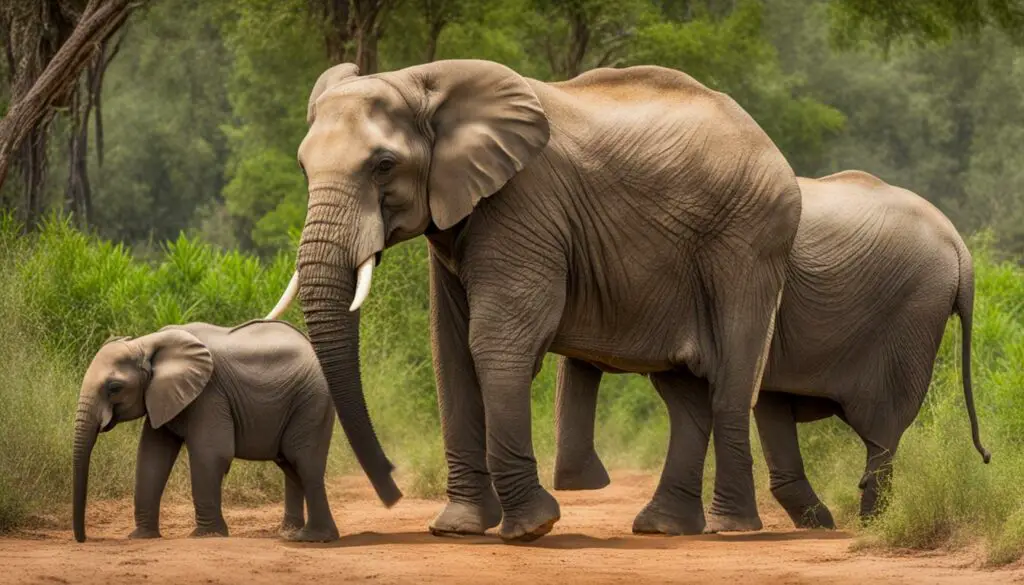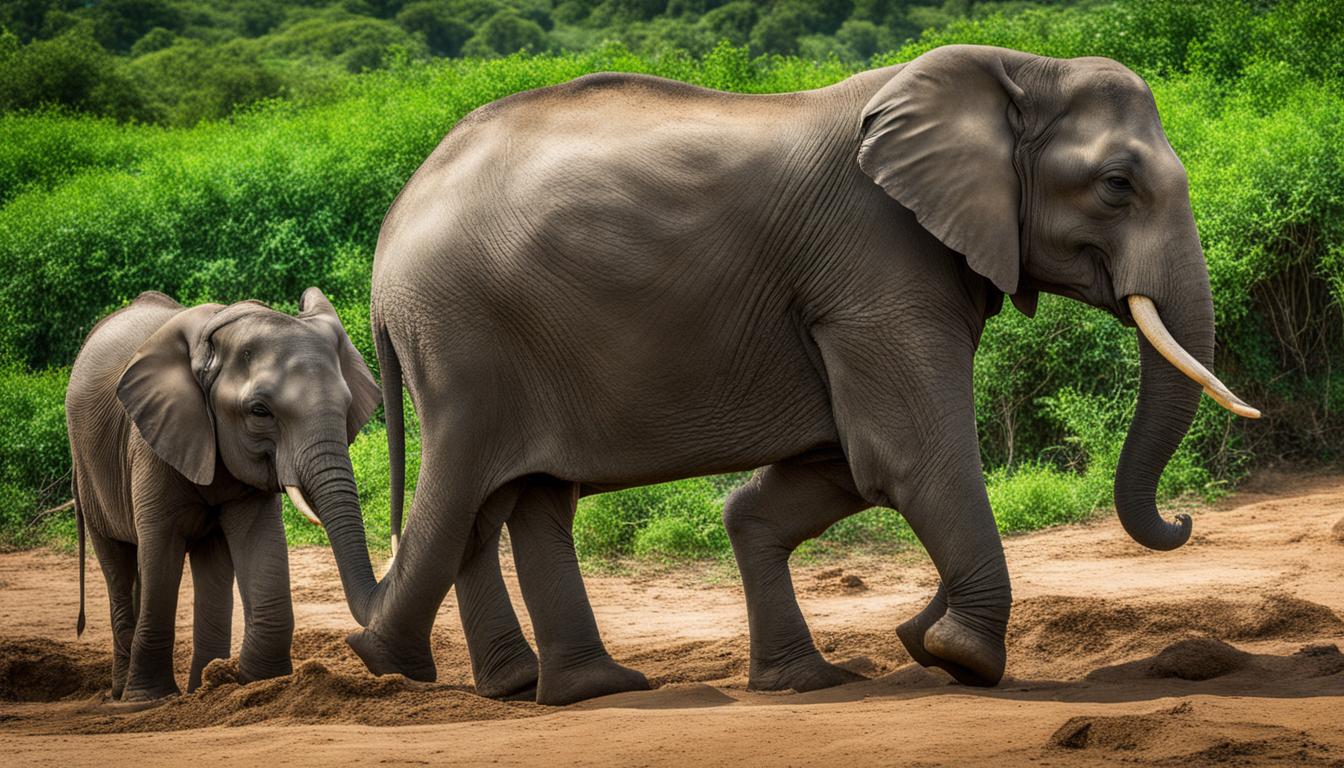Elephants, majestic creatures known for their size and intelligence, go through a remarkable journey of growth and development throughout their lives. Understanding the stages of an elephant’s life, from reproduction to aging, gives us a deeper appreciation for these magnificent animals.
From the moment of birth, elephants embark on a unique life cycle. They live in small family groups, led by wise and experienced matriarchs. Male elephants form bachelor herds, supporting each other in a brotherly bond.
Elephants of all ages and sexes secrete a special fluid called temporin, which plays a role in their social interactions. Male elephants go through a musth period, during which they exhibit peculiar behavior and secrete a different fluid. This period is crucial for establishing reproductive hierarchy.
Gestation in elephants is the longest of any mammal, lasting between 18 to 22 months. When newborn elephants enter the world, they weigh around 100 kilograms. They rely on their mother’s milk for sustenance, using their mouths to suckle. As they grow, young elephants develop their motor skills and begin feeding on their own.
Elephants reach sexual maturity at different ages. African elephants become mature around 10 to 12 years old, while Asian elephants mature a bit later, around 14 years old. Once mature, males leave their birth herd, while females remain with their natal herd for life.
Throughout their lives, elephants continue to grow and develop, with males reaching heights of up to 12 feet and weighing up to 5 tons. They can live to be 80 years or more in captivity, but their average lifespan in the wild is around 60 years.
These incredible animals migrate seasonally and possess remarkable memory and intelligence, making them a vital part of the ecosystems they inhabit.
Join us as we dive deeper into the fascinating world of elephant life, exploring their mating and reproduction, development and growth stages, aging process, and the crucial role they play in our world.
Elephant Mating and Reproduction
When it comes to elephant reproduction, there are several fascinating aspects to explore. Elephants do not have a set breeding season, but births are more frequent during times of heavy rainfall. Female elephants have estrus cycles lasting 13-16 weeks, with ovulation lasting about four days. Male elephants, on the other hand, seek mates during their musth period, which can last 6-12 weeks.
The musth period is a time of heightened reproductive activity for male elephants. During this time, they secrete a different fluid and exhibit erratic behavior. It is crucial for establishing reproductive hierarchy among males. Interestingly, elephants can assess the reproductive status of others by their sense of smell, allowing them to determine suitable mating partners.
After successful mating, female elephants have the longest gestation period of any mammal, lasting 22 months. This prolonged period is necessary for the development of the calf. Once born, elephant calves weigh around 265 pounds and are able to see, smell, and walk within an hour. They depend on their mother’s milk for the first few months, suckling from her mammary glands located in the chest region. Weaning occurs gradually, sometimes continuing until the mother can no longer tolerate the pokes of her offspring’s emerging tusks.
| Key Points | Elephant Mating and Reproduction |
|---|---|
| Gestation Period | 22 months |
| Birth Weight | Around 265 pounds |
| Maternal Care | Dependent on mother’s milk for the first few months |
| Weaning | Gradual process until the mother can no longer tolerate the pokes of emerging tusks |
“The musth period is a fascinating phenomenon that occurs in male elephants and serves as a crucial time for reproductive hierarchy. It demonstrates the complexity and precision of their mating behaviors.”
Estrus Cycle and Musth Period
The estrus cycle of female elephants and the musth period of males are central to the elephant’s reproductive process. Understanding these unique aspects allows us to appreciate the intricacies of elephant mating and reproduction.
- Female elephants have estrus cycles lasting 13-16 weeks, with ovulation lasting about four days.
- Male elephants enter a musth period, which can last 6-12 weeks, during which they exhibit erratic behavior and secrete a different fluid.
- Musth is the time for establishing reproductive hierarchy among male elephants.
- Elephants can assess the reproductive status of others by their sense of smell, enabling them to determine suitable mates.
By diving into the complexities of elephant mating and reproduction, we gain a deeper understanding of these magnificent creatures. Their unique behaviors and reproductive processes contribute to the sustainability of elephant populations and highlight the importance of conservation efforts.
Elephant Development and Growth Stages
Throughout their lives, elephants go through various stages of development and growth, each crucial to their overall well-being. Understanding these stages is essential for gaining insight into the fascinating journey of an elephant’s life.
During the infancy stage, which lasts for the first three months, elephant calves focus on developing their motor skills and coordination. They start attempting to feed on their own at around 3-4 months of age, gradually gaining independence. However, they continue to nurse from their mothers for two to three years, receiving vital nutrients and protection.
As young elephants transition into adolescence, their growth rate slows down, and they begin to exhibit more complex behaviors. Both male and female elephants experience similar rates of growth and developmental milestones during their first 10 years of life. Around 10-12 years old, African elephants reach sexual maturity, while their Asian counterparts attain sexual maturity slightly later, at around 14 years old.
Elephant Growth Stages
| Stage | Description |
|---|---|
| Infancy | Development of motor skills and learning to feed |
| Adolescence | Growth rate slows down, exhibiting complex behaviors |
| Adulthood | Sexual maturity and independent living |
Once elephants reach adulthood, they undergo significant physical and behavioral changes. Males leave their birth herd, while females remain with their natal herd for life. Adult elephants continue to grow throughout their lives, with males reaching heights of up to 12 feet at the shoulders and weighing up to 5 tons. These magnificent creatures continue to display their intelligent and social nature, contributing to the overall richness and diversity of their ecosystem.
By understanding the different growth stages elephants go through, we can gain a deeper appreciation for their journey from infancy to adulthood. It also highlights the importance of protecting and conserving these magnificent animals, ensuring their continued existence for generations to come.
Elephant Aging and Life Span
Understanding the aging process and life span of elephants is crucial in ensuring their well-being and conservation. These magnificent creatures can live to 80 years or more in captivity, but their average life span in the wild is around 60 years. The aging process in elephants is gradual, and their growth rate slows as they get older.
Research suggests that factors such as the wear and tear on their bodies and the accumulation of stress over time contribute to their life span. Interestingly, male elephants may experience a second growth spurt when they reach around 20 years old. This phenomenon highlights the complexity of elephant growth and aging.
“The aging process in elephants is gradual, and their growth rate slows as they get older.”
While elephants do not show clear signs of aging, their behavior and physical capabilities may change over time. Older elephants may have reduced mobility, weakened senses, and increased vulnerability to diseases. Despite these challenges, elephants continue to play vital roles in their ecosystems, shaping their environment and contributing to biodiversity.
| Age | Characteristic |
|---|---|
| Infancy to Adolescence | Rapid growth and development |
| Adulthood | Continued growth with males reaching heights up to 12 feet at the shoulders and weighing up to 5 tons |
| Old Age | Reduced mobility, weakened senses, increased vulnerability to diseases |
Protecting elephants and their habitats is crucial in ensuring their long-term survival. By conserving these majestic creatures, we not only preserve a critical piece of our natural heritage but also maintain the balance of ecosystems they inhabit. Together, let’s work towards a future where elephants can thrive and continue to inspire awe and wonder.

The Importance of Elephants to Humans
Elephants have played a significant role in human history, serving as more than just magnificent creatures roaming the wilderness. Throughout the ages, humans have recognized the importance of elephants and capitalized on their unique abilities. From their domestication to their involvement in warfare, elephants have left an indelible mark on our collective consciousness.
Domestication of Elephants
The domestication of elephants, although not in the same way as other animals like cattle or horses, has been a remarkable achievement. Skilled handlers called mahouts have tamed and trained elephants, harnessing their immense physical strength and intelligence for tasks ranging from transportation and agriculture to cultural and ceremonial purposes.
Elephants in War
Elephants have also played a pivotal role in warfare throughout history. One notable example is Hannibal’s crossing of the Alps with elephants during the Second Punic War. These majestic creatures were used as formidable weapons, instilling fear in the hearts of their opponents and providing a tactical advantage on the battlefield.
Additionally, elephants have been deployed in ancient and medieval battles, serving as living tanks or mobile platforms from which archers could rain arrows upon their enemies. Their imposing size and strength made them highly effective in breaking enemy lines and creating chaos amidst the enemy ranks.
Conservation of Elephants
Today, the conservation of elephants is of paramount importance. These magnificent creatures face numerous threats, including habitat loss, poaching for their ivory, and human-elephant conflict. Efforts to protect and conserve elephants are crucial not only for the survival of these majestic animals but also for the preservation of the delicate ecosystems they inhabit.
Conservation organizations and governments around the world are working tirelessly to implement strategies to safeguard elephant populations and their habitats. These efforts include initiatives to combat illegal wildlife trafficking, establish protected areas, and promote sustainable coexistence between elephants and human communities.
The significance of elephants in human history cannot be overstated. Their role in domestication, warfare, and the ongoing battle for conservation highlights the deep connection between elephants and humanity. By recognizing and valuing the importance of elephants, we can contribute to their preservation and ensure a future where these magnificent creatures continue to roam the earth.
Conclusion
African elephants have a fascinating life cycle, from birth to adulthood. They live in family groups, exhibit complex social behaviors, and have long gestation periods. Their growth and development stages are gradual, with unique characteristics distinguishing them from their savanna cousins.
Elephants play important roles in maintaining ecosystems and have a profound impact on their environment. However, they face significant challenges, including habitat loss, poaching, and human-elephant conflict. Conservation efforts and sustainable practices are essential to ensure a brighter future for elephants and the ecosystems they inhabit.
By understanding and appreciating the life cycle of elephants, we can better advocate for their protection and conservation. It is crucial to raise awareness about the importance of elephants and their role in the delicate balance of nature. Together, we can work towards preserving these magnificent creatures for future generations to enjoy.
How Does the Life Cycle of an Elephant Affect Their Average Lifespan in the Wild?
The average lifespan of wild elephants is influenced by their life cycle. Elephants go through different stages, from birth to adulthood, and their lifespan can be affected by factors such as predation, disease, and food availability. The longer an elephant survives these challenges, the higher the chances of reaching their average lifespan in the wild.
FAQ
What is the life cycle of an elephant from birth to adulthood?
Elephants go through various stages in their life cycle. They start as newborn calves, weighing around 100 kg and dependent on their mother’s milk. As they grow, they develop their motor skills and begin feeding on their own. Young elephants remain with their natal herd, and both males and females exhibit similar rates of growth for the first 10 years. At around 10-12 years old, African elephants reach sexual maturity, while Asian elephants become sexually mature slightly later, around 14 years old. Males leave their birth herd, while females remain with their natal herd for life. Adult elephants continue to grow throughout their lives, with males reaching heights of up to 12 feet at the shoulders and weighing up to 5 tons.
How do elephants mate and reproduce?
Female elephants have estrus cycles lasting 13-16 weeks, and ovulation lasts about four days. Male elephants seek mates during their musth period, which can last 6-12 weeks. Female elephants give birth to a single calf after a gestation period of 22 months. Calves weigh around 265 pounds at birth and are able to see, smell, and walk within an hour. They suckle from their mother’s mammary glands located in the chest region and are dependent on their mother’s milk for the first few months. Weaning occurs gradually and can continue until the mother can no longer tolerate the pokes of her offspring’s emerging tusks.
How do elephants develop and grow?
During the first three months, elephant calves develop their motor skills and begin feeding on their own at around 3-4 months. They continue to nurse for two to three years. Young elephants remain with their natal herd even after being weaned. Both male and female elephants exhibit similar rates of growth and developmental stages for the first 10 years of life. At around 10-12 years old, juvenile elephants’ growth rates begin to slow. African elephants reach sexual maturity between 10-12 years old, while Asian elephants become sexually mature slightly later, at around 14 years old.
How do elephants age and what is their life span?
Elephants can live to 80 years or more in captivity but only about 60 years in the wild. The aging process in elephants is gradual, and their growth rate slows as they get older. There is evidence that male elephants may have a second growth spurt when they are around 20 years old. The exact factors that determine an elephant’s aging process are still not fully understood, but research suggests that the wear and tear on their bodies and the accumulation of stress over time contribute to their life span.
What is the importance of elephants to humans?
Elephants have been important to humans for many centuries. They have been used as ceremonial and draft animals. While they have not been domesticated in the same way as other animals, such as cattle or horses, elephants have been tamed and trained by skilled handlers called mahouts. Elephants have played significant roles in historical events, such as Hannibal’s crossing of the Alps with elephants in war. In modern times, elephants have become important symbols of power and pageantry, although their use in logging operations has been largely replaced by machinery. Conservation efforts are crucial to protect elephants, as their populations have been threatened by habitat loss, poaching, and the ivory trade.










